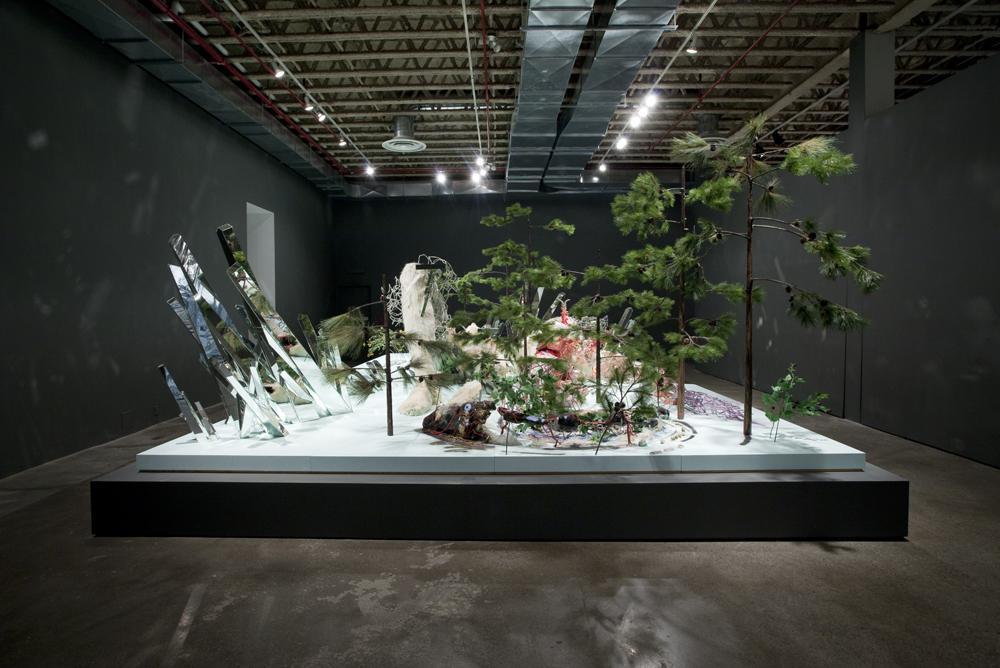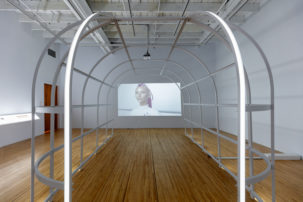It’s a bit of a tease. As winter clings to Toronto, spring begins to emerge underneath. In our fortress of concrete and skyscrapers, grasses force their way through cracks in sidewalks, pollen threatens its return, traces of bird calls are heard amid raccoons screeching, and road salt continues its inexorable chewing-through of boots, pavement and cars.
In this way, spring is a return of the undead. And in MOCCA’s latest exhibition, “Misled by Nature: Contemporary Art and the Baroque,” the infringement of the environment on human infrastructure, both menacing and majestic, is made material.
This exhibition, which unites MOCCA with the Art Gallery of Alberta and the National Gallery of Canada, is ambitious—both in terms of the expansiveness of works and in the curatorial and institutional collaboration. The exhibition is curated by Catherine Crowston of the AGA, where the exhibition first showed in 2012, as well as by Josée Drouin-Brisebois and Jonathan Shaughnessy of the NGC, from whose collection some of the exhibition’s work comes.
Critical consensus so far seems to be that the exhibition suffers from a mischaracterization of the baroque. Sky Goodden of Blouin ArtInfo has articulated a desire for the complications, provocations and wonderment of the baroque to be better represented in the exhibition. While she does not doubt the existence of the neo-baroque as an artistic movement, she suggests this exhibition is not quite it. New Yorker art critic Peter Schjeldahl apparently agreed at his Toronto talk in late February, suggesting that the descriptor “baroque” is now a sort of convenient shorthand for “excessive” or “decorative,” and that the exhibition falls short of a truly baroque sensibility.
Such comments are worthwhile, and while the exhibition is certainly powerful, the term baroque is a bit of a red herring. At the heart of it, as the exhibition’s title (a repurposing of Winckelmann’s critique of Bernini) suggests, is a productive preoccupation with the falseness of the nature-culture dichotomy. This question of the relationship between nature and culture, manifesting throughout the exhibition, is far more provocative than the promise of a new baroque.
David Altmejd‘s The Holes (2008) is the perfect opening to the exhibition. Like a theme park of nature, Altmejd’s reflective mirror crystals give the installation the illusion of scale beyond the platform that confines it, and hints at secret spaces. Walking around Altmejd’s installation is akin to looking in on a natural history museum diorama, with much of the same surprise and delight, and an added uncanniness. Catch a reflection of your own eye in one of Altmejd’s crystals and ber immediately disarmed. A sprawled body, as if decomposing, lies at the centre of the installation, apparently the catalyst for the crystals, branches, guts and eggs that have sprung up around it. If Altmejd has been misled by nature in some spectacular and apocalyptic vision, he also grasps its processes, fast and slow, and its refusal to be subdued.
Tricia Middleton’s installation mimics the natural processes of reclamation upon a ruin of insulation foam, wax and cheap trinkets. Middleton’s process is a strange kind of recycling—a reuse of what she deems “studio runoff,” referring to the material remains of her previous installations and sculptural experiments. At the forefront of the work is not nature, but Middleton’s own artistic practice. The work’s title, Embracing oblivion and ruin is the only way to live now, could just as easily be a manifesto for Middleton’s practice, in which she is the agent of ruin and reclamation.
Lee Bul’s After Bruno Taut (Negative Capability) (2008) claims to refer back to the German architect’s utopian vision of a floating glass city, but equally conjures up images of Piranesi’s etchings of prisons. The swooping, structural lines of the chandelier-like sculpture, despite their enticing sparkle, are not simply sweet and dreamy, but chain-like, tethered, tangled. The sculpture is huge, precious, ambitious, but also dangling, precarious, even threatening. Bul’s dream of culture’s divorce from the exterior world is a space confined by glass, cordoned off with glitter.
While Altmejd, Middleton and Bul revel in the theatrics of culture’s play with nature, Yinka Shonibare, Bharti Kher and Mark Bradford take up the politics of nature and culture.
The doctrine of naturalness has long been a tool of oppression, proclaiming ethnic, gender, sexual, and class hierarchies, and legitimizing culture’s own constructions. In Mark Bradford’s Africa (2013), the artist plays with the conventions of cartography—its biases and intangibilities. Based on a 17th-century Dutch map of Africa, his painting, and an accompanying sculptural painted sphere, gesture to the colonial impulse to document, control, hold and quantify land. At the same time, Bradford’s globe-like object begs to be picked up, provoking us to feel our way through geography, or daring us to mimic the colonial act of seizing territory, holding the whole world in our hands.
Yinka Shonibare’s 1998 reimagining of a Thomas Gainsborough painting, Mr. and Mrs. Andrews without their Heads, recasts the couple in West African Batik (introduced to Africa by way of the Dutch, who encountered it first in Indonesia). The work also severs the couple from the land they preside over in Gainsborough’s painting. As Shonibare removes the couple from their landscape, he also reveals the boastfulness of the original portrait: a document of ownership and wealth. Without their heads, the two figures are stripped of their agency, while their dog, straddling the boundaries of nature and the domestic, pleads up at us, left in limbo.
While Shonibare’s work is well documented as an exploration of colonial histories, the cultural significance of pattern and decoration finds another outlet in Bharti Kher’s works, made of layers of Bindis. In explosive patterns, they echo lichens, cell-formation and clusters of sperm. Atop it all, a series of black bindis running vertically through the work recall tire tracks. In Kher’s work, the rich patterns of the natural world are both created by and overpowered with inescapable cultural referents.
Given Kher, Shonibare and Bradford’s critical engagement with colonialism, a deeper problem with the use of the term “baroque” in the exhibition’s subtitle becomes apparent. Since the 17th-century baroque (a thoroughly European movement) often relied on the cultural appropriation of decorative motifs and on the material spoils of colonization as objects of extravagance and luxury, why not do away with the term altogether in attempting to describe our contemporary moment? Shonibare, Kher and Bradford are not failing to be baroque. Rather, they push against the baroque’s historical place in pursuit of something more useful.
Though they lack a bit of the spectacle and awe of Altmejd, Middleton and Bul’s works, Kher, Shonibare and Bradford’s contributions present more pressing questions arising from the divide between nature and culture. Namely: How has nature been mobilized as a tool to prop up established ideologies and existing social structures? And by thinking of nature as the realm of objective scientific study, how have we remained complicit in the fictions of naturalness that govern our behaviour?
Ultimately, nature and culture remain the most exciting premises of this exhibition. While Altmejd, Middleton and Bul show us the absolute artifice of our constructed view of nature, Shonibare, Kher and Bradford reveal the political implications of that artifice—even as it is embedded in the terminology of the exhibition itself.









